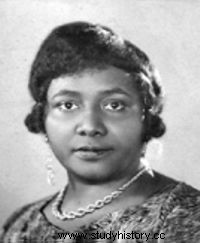Paulette Nardal (1896-1985), is a Martinican woman of letters, inspiration of the literary current of negritude claiming black identity. She is also the first black woman to study at the Sorbonne.
The Harlem Renaissance
 Paulette Nardal is the eldest of the seven daughters of Louise Achille and Paul Nardal, an engineer. Born in François, a Martinican town, in 1896, she was six years old during the deadly eruption of Mount Pelee in 1902, destroying in a few moments the city of Saint-Pierre, the largest on the island. After obtaining the equivalent of the baccalaureate, Paulette became a teacher then, in 1920, decided to settle in France to study English at the Sorbonne. In doing so, she becomes the first black woman to study there.
Paulette Nardal is the eldest of the seven daughters of Louise Achille and Paul Nardal, an engineer. Born in François, a Martinican town, in 1896, she was six years old during the deadly eruption of Mount Pelee in 1902, destroying in a few moments the city of Saint-Pierre, the largest on the island. After obtaining the equivalent of the baccalaureate, Paulette became a teacher then, in 1920, decided to settle in France to study English at the Sorbonne. In doing so, she becomes the first black woman to study there.
In Paris, Paulette enjoys cultural life, theatre, concerts and exhibitions. Having obtained her diploma, she became a journalist and began to hold, with her sisters Andrée and Jeanne who lived with her, a literary salon. It is particularly close to the Harlem Renaissance movement, a revival of African-American culture born in New York. In their living room, frequented by many writers, the Nardal sisters strive to connect the black diasporas, to defend black culture. They and their guests laid the groundwork for what would later be the current of Negritude, notably bringing together Léopold Senghor and Aimé Césaire.
The current of Negritude
Paulette Nardal, her sister Andrée and the Haitian writer Léo Sajous found "La Revue du Monde Noir “, published in French and English, which gives a platform to black people around the world to discuss their problems and claim their culture. The journal has only six issues, for lack of money to continue publishing, but other journals subsequently launch on the same themes. Césaire and Senghor took up the torch with the current of Negritude, and Paulette would write on this subject:"Césaire and Senghor took up the ideas that we brandished and expressed them with much more sparks, we were not only women! We have marked the slopes for men . »
Feeling close to Africa and Africans, Paulette went to Senegal in 1937 at the invitation of her friend Senghor and became politically involved against the invasion of Ethiopia by Italy in 1938. The following year, then she returns from Martinique by boat, her ship is sunk by a German submarine. Paulette manages to save herself by throwing herself into a lifeboat, but fractures both kneecaps in the fall; she will remain crippled for life. As soon as she left the English hospital where she was treated, she returned to live in Martinique where she secretly gave English lessons to young people wishing to join Charles de Gaulle in London.
"Black is beautiful!" »
In 1944, Paulette Nardal worked for a while at the United Nations in New York, but her health forced her to return to settle in Martinique. In 1945, she created the Rassemblement Féminin to encourage Martiniquaises to use the right to vote that French women had just obtained. In 1948, with the same aim of making her fellow citizens aware of politics, she launched the magazine La femme dans la cité . An activist, Paulette fights for the construction of nurseries and financial assistance for single mothers, without leaving aside the defense of the black culture that is dear to her. Passionate about music, she wrote with her sister Alice a history of the musical tradition of the Martinican countryside, and founded a choir. To her students, her friends, her acquaintances, she tirelessly repeats “Black is beautiful! »
Paulette Nardal died on February 16, 1985, at the age of 89.
